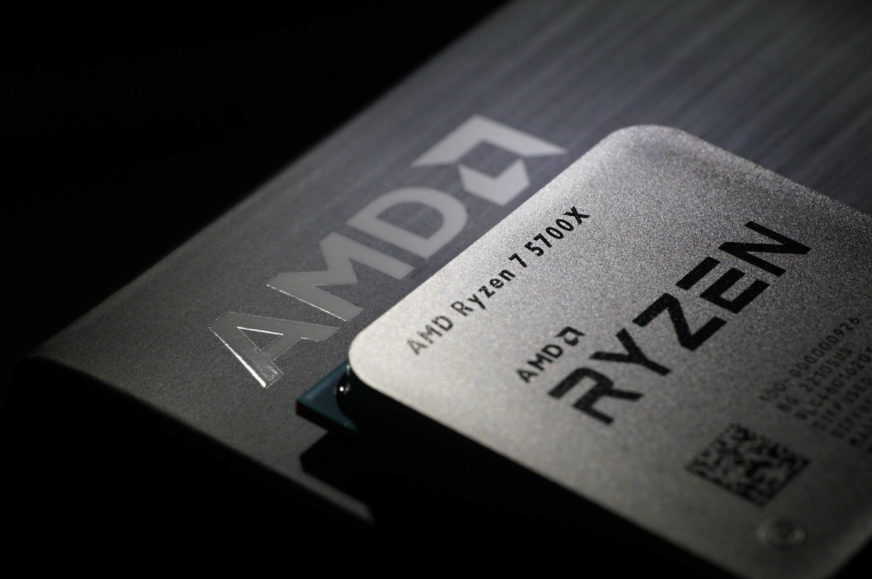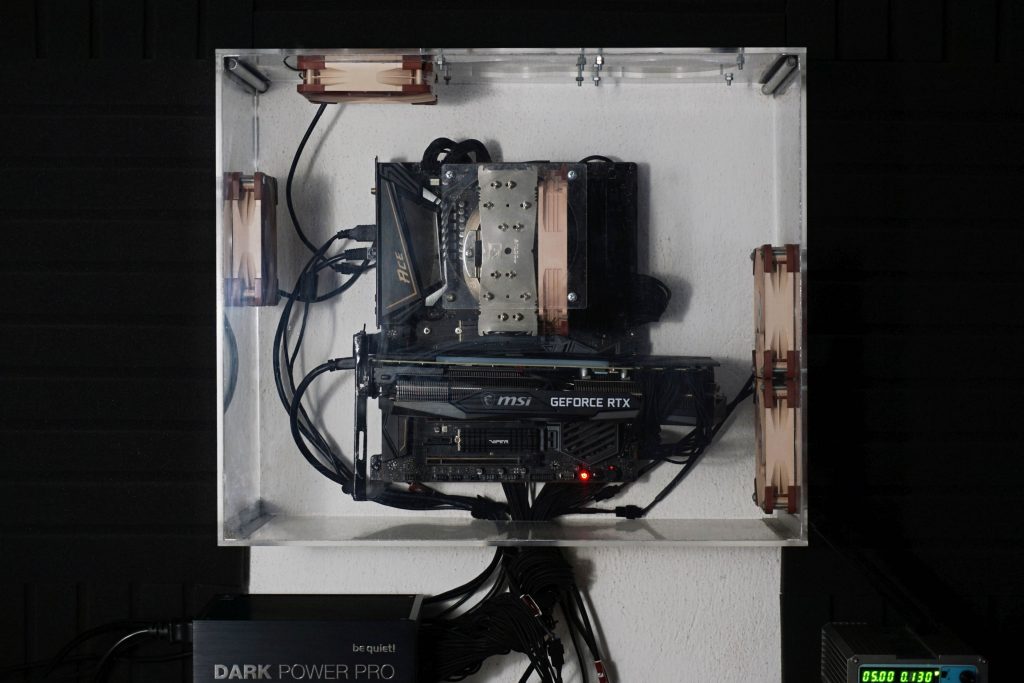Methodology: temperature and clock speed tests
At the eleventh hour, but still. The long-awaited Ryzen 7 5700X is here. However, we won’t be writing about the successor to the Ryzen 7 3700X as a significantly cheaper alternative to the Ryzen 7 5800X. The new octa-core Ryzen 7 5700X is primarily more economical compared to the higher-end model. Its power draw is just half in some tasks, which means that temperatures are also significantly lower.
Methodology: temperature and clock speed tests
When choosing a cooler, we eventually opted for Noctua NH-U14S. It has a high performance and at the same time there is also the TR4-SP3 variant designed for Threadripper processors. It differs only by the base, the radiator is otherwise the same, so it will be possible to test and compare all processors under the same conditions. The fan on the NH-U14S cooler is set to a maximum speed of 1,535 rpm during all tests.
Measurements always take place on a bench-wall in a wind tunnel which simulates a computer case, with the difference that we have more control over it.
System cooling consists of four Noctua NF-S12A PWM fans, which are in an equilibrium ratio of two at the inlet and two at the outlet. Their speed is set at a fixed 535 rpm, which is a relatively practical speed that is not needed to be exceeded. In short, this should be the optimal configuration based on our tests of various system cooling settings.
It is also important to maintain the same air temperature around the processors. Of course, this also changes with regard to how much heat a particular processor produces, but at the inlet of the tunnel it must always be the same for accurate comparisons. In our air-conditioned test lab, it is currently in the range of 21–21.3 °C.
Maintaining a constant inlet temperature is necessary not only for a proper comparison of processor temperatures, but especially for unbiased performance comparisons. Trend of clock speed and especially single-core boost depends on the temperature. In the summer at higher temperatures, processors may be slower in living spaces than in the winter.
For Intel processors, we register the maximum core temperature for each test, usually of all cores. These maximum values are then averaged and the result is represented by the final value in the graph. From the outputs of single-threaded load, we only pick the registered values from active cores (these are usually two and alternate during the test). It’s a little different with AMD processors. They don’t have temperature sensors for every core. In order for the procedure to be as methodically as possible similar to that applied on Intel processors, the average temperature of all cores is defined by the highest value reported by the CPU Tdie sensor (average). For single-threaded load, however, we already use a CPU sensor (Tctl/Tdie), which usually reports a slightly higher value, which better corresponds to the hotspots of one or two cores. But these values as well as the values from all internal sensors must be taken with a grain of salt, the accuracy of the sensors varies across processors.
Clock speed evaluation is more accurate, each core has its own sensor even on AMD processors. Unlike temperatures, we plot average clock speed values during tests in graphs. We monitor the temperature and clock speed of the processor cores in the same tests, in which we also measure the power consumption. And thus, gradually from the lowest load level on the desktop of idle Windows 10, through audio encoding (single-threaded load), gaming load in three games (F1 2020, Shadow of the Tomb Raider and Total War Saga: Troy), to a 10-minute load in Cinebench R23 and the most demanding video encoding with the x264 encoder in HandBrake.
To record the temperatures and clock speed of the processor cores, we use HWiNFO, in which sampling is set to two seconds. With the exception of audio encoding, the graphs always show the averages of all processor cores in terms of temperatures and clock speed. During audio encoding, the values from the loaded core are given.
- Contents
- AMD Ryzen 7 5700X in detail
- Methodology: performance tests
- Methodology: how we measure power draw
- Methodology: temperature and clock speed tests
- Test setup
- 3DMark
- Assassin’s Creed: Valhalla
- Borderlands 3
- Counter-Strike: GO
- Cyberpunk 2077
- DOOM Eternal
- F1 2020
- Metro Exodus
- Microsoft Flight Simulator
- Shadow of the Tomb Raider
- Total War Saga: Troy
- Overall gaming performance
- Gaming performance per euro
- PCMark and Geekbench
- Web performance
- 3D rendering: Cinebench, Blender, ...
- Video 1/2: Adobe Premiere Pro
- Video 2/2: DaVinci Resolve Studio
- Graphics effects: Adobe After Effects
- Video encoding
- Audio encoding
- Broadcasting (OBS and Xsplit)
- Photos 1/2: Adobe Photoshop and Lightroom
- Photos 2/2: Affinity Photo, Topaz Labs AI Apps, ZPS X, ...
- (De)compression
- (De)cryption
- Numerical computing
- Simulations
- Memory and cache tests
- Processor power draw curve
- Average processor power draw
- Performance per watt
- Achieved CPU clock speed
- CPU temperature
- Conclusion











Nice review, especially the details in the Premiere Pro part.
However, there are some questionable results, namely the “4K H.264, 2× Forward Live Playback [avg. fps] – higher is better” and others, where the 5700X is last by a wide margin. Have you redone the tests (or ran similar tests) to see if this was just an outlier? It would have been nice to at least have a comment on such a weird result…
Thanks for your comment. The explanation is in the text of the final chapter, and I also explain this behavior in the Ryzen 5 5600 test, which performs better, but is still the second processor from the bottom in the charts. The point is that 4K H264 live playback is a single-threaded task in Premiere Pro, but because of the utilization of the other cores by other application processes, the frequencies are only at the all-core boost level. These are pretty conservative for the Ryzen 7 5700X from today’s perspective (the 5600 is 300 MHz faster here, hence the higher fps), plus Zen 3 doesn’t handle 4K H.264 well overall, and better results are achieved with both 4K ProRes 222 and 4K RED.
Thanks for replying. I read the explanation at the end of the review, but “the 500 MHz difference” still didn’t seem to be enough of a reason for such a big difference. Something else must be at play here, though I am also not sure of what it may be.
why in total war troy 5600x shows more fps than 5700x? after all, this strategy loads the processor well and, according to the logic, the 16th nuclear one should have come out with a large margin from the 12th nuclear one !! ps: I myself am a fan of total war warhammer 1/2/3 and have a 5600x processor, but yesterday I ordered a new 5700x processor
The reason for this is apparently very simple. The 6 cores/12 threads of the R5 5600X processor do not represent a bottleneck for TWST, and higher clock speeds are decisive for higher performance. And those the R7 5700X achieves are lower.
Great review, really liking the detailed analysis. I saw a comment on reddit that linked to this review stating that if the 5800x was limited to 65w TDP, the performance efficiency might be similar to the 5700x. Have you thought about testing this out?
Thanks for your comment. Due to a lot of time pressure, we probably won’t be testing the R7 5800X with reduced power draw anymore. But if we see a similar situation with the Ryzen 7000 and something like the R7 6700(X) and R7 6800, we’ll definitely take a look at it. However, it’s good to note that such analyses require multiple CPU samples to operate outside of their specs. The fact that a single 5800X sample would be limited to 65W and the performance was higher than the R7 5700X@TDP/65W doesn’t mean anything relevant yet.
It’s similar to overclocking. Based on one sample, it is not possible to generalize that this or that frequency will be achieved at xyz W of power draw. You always have to evaluate it based on multiple samples of processors and sooner or later we will get to that and once we have more of them (those test samples) we will for sure look at the variance of the measured values across the samples as well.